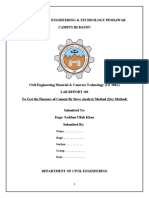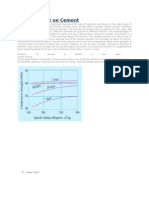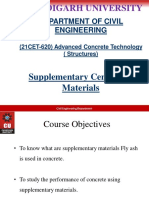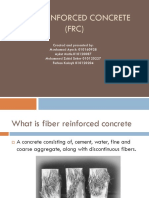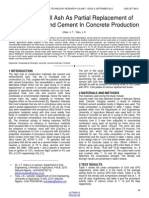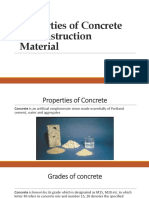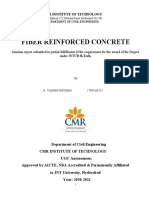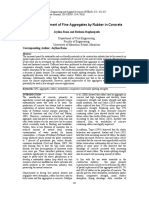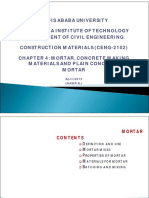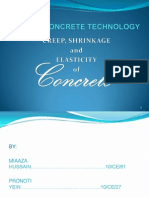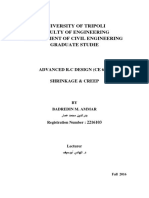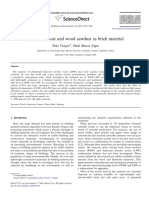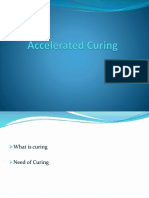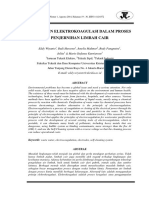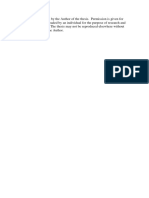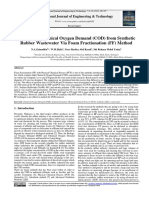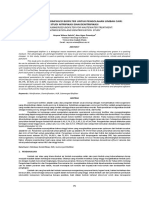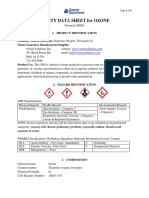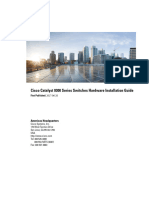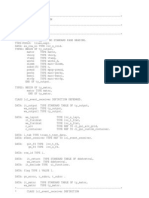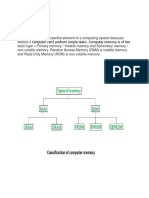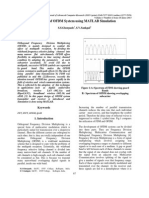Waste Glass in Cement Mortar
Waste Glass in Cement Mortar
Uploaded by
HasnanurfajriahCopyright:
Available Formats
Waste Glass in Cement Mortar
Waste Glass in Cement Mortar
Uploaded by
HasnanurfajriahCopyright
Available Formats
Share this document
Did you find this document useful?
Is this content inappropriate?
Copyright:
Available Formats
Waste Glass in Cement Mortar
Waste Glass in Cement Mortar
Uploaded by
HasnanurfajriahCopyright:
Available Formats
INTERNATIONAL JOURNAL OF CIVIL AND STRUCTURAL ENGINEERING
Volume 3, No 4, 2013
Copyright by the authors - Licensee IPA- Under Creative Commons license 3.0
ISSN 0976 4399
Research article
Use of waste glass in cement mortar
Bhandari. P.S1, Tajne. K.M2
1- Assistant Professor, Priyadarshini College of Engineering, Nagpur
2- Assistant Professor, Priyadarshini College of Engineering, Nagpur
pranita.bhandari11@gmail.com
doi: 10.6088/ijcser.201203013064
ABSTRACT
The need to add value to wastes and the opening towards the use of sand replacement
materials, both in mortars and concretes, with the purpose of promoting increased
sustainability of building materials, were the grounds for this work that aims the formulation
of mortars with crushed glass aggregate. In this paper, a parametric experimental study for
producing mortar blocks using fine and coarse waste glass is presented. Mechanical
properties of mortar blocks having various levels of fine glass (FG) and coarse glass (CG)
replacements with fine aggregate (FA) are investigated. The test results show that the
replacement of Fine aggregate by Fine Glass at level of 20% by weight has a significant
effect on the compressive strength of the mortar blocks as compared with the control sample
because of pozzolanic nature of FG. Results indicate pozzolanic reactivity of this waste and
open possibilities for the use of this material in mortars
Keyword: Mortar block, Pozzolanic, Waste glass, Fine Glass, Coarse Glass.
1. Introduction
In recent years there has been an increasing worldwide demand for the construction of
buildings, roads and airfields which has led to a local depletion of aggregates. In some urban
areas, the enormous quantities of aggregate that have already been used means that local
materials are no longer available and the deficit has to be made up by importing materials
from other locations. Most cities have areas of land covered by spoil heaps which are
unsightly and prevent large areas of land being used for anything else.
If the large amount of waste materials generated were used instead of natural materials in the
construction industry there would be three benefits: conserving natural resources, disposing
of waste materials (which are often unsightly) and freeing up valuable land for other uses[J
Blewett et al., 2000]. Glass is a common product that can be found in different forms: bottles,
jars, windows and windshields, bulbs, cathode ray tubes, etc. These products have a limited
lifetime and must be used in order to avoid environmental problems related to their
stockpiling or land filling. Several recycling channels already exist for glass recovery. This
project deals with the recycling of glass bottles, which can usually be reused after being
crushed and melted. This operation is easily feasible when the glass is recovered as separate
colors to produce glass products of the same color. However, most of the time, the collected
glass is mixed and so unusable for the production of bottles of a given color. Consequently,
this glass can either be reused for other but limited purposes, or be sent to a landfill.
Due to the limited landfill space available and stringent environmental regulations, many
waste glasses are attempting to develop efficient, economic and environmental sound
alternatives for utilizing this waste glass. Therefore, the civil engineers have been challenged
to convert this waste glass, in general, to useful building and construction materials.
Received on May, 2013 Published on August 2013
704
Use of waste glass in cement mortar
Bhandari. P.S, Tajne. K.M
Utilization of waste glass for construction shall not only solve waste problems, but also
provide a new resource for construction purposes. The use of waste glass as a substitute for
fine aggregates in mortar mix is one option that can alleviate waste glass disposal problem
and has been studied widely in recent years. Despite of the recent studies, there are still many
unknowns with the use of waste glass. Study is needed to determine the contribution of waste
glass to the performance of hardened mortar. There are great concerns on the strength and
durability of the mortar being produce with replacement material when used as construction
materials in the construction industries. If it is proven that the mortar is durable and strong,
this will lead to the use of waste glass to replace part of the fine aggregate in mortar. Finally,
this study also aims to determine the most suitable mix proportion that can produce mortar of
desirable strength without compromising engineering performance and quality.
2. Materials
2. 1. Aggregate
In this study two type of sand is used (1) Standard sand - Standard sand conforming from IS
650:1991 used for control mortar block.(2) Natural Sand - Fine aggregate resulting from the
natural disintegration of rock and which has been deposited by streams or glacial agencies.
The Wainganga sand was used as natural river sand.
2.2. Water
Water used for making masonry mortars shall be clean and free from injurious quantities of
deleterious materials. Potable water is considered satisfactory for use in masonry mortar. For
further requirements regarding limits of deleterious materials permitted reference may be
made to IS 456-1978.
2.3. Cement
Ordinary Portland cement 53 grade (ultratech cement) complying with IS 269, 1976 was used.
The cement was kept in an airtight container and stored in the humidity controlled room to
prevent cement from being exposed to moisture. The grade 53 is known for its rich quality
and is highly durable. Hence it is used for constructing bigger structures like building
foundations, bridges, tall buildings, and structures designed to withstand heavy pressure.
With a good distribution network this cement is available most abundantly in Gujarat. The
chemical and physical properties of this material were shown in Table 1.1.
Table 1: Properties of cement
Sr. No.
1
2
3
4
5
6
7
8
Chemical Ingredients
Lime
Silica
Alumina
Iron Oxide
Magnesium Oxide
Sulphur Trioxide
Alkalies such as soda & potash
Loss on ignition
Range %
60-70
17-25
3-8
0.5-6
0.4-4
1-3
0.2-1
1-2
Common Proportion
63
22
6
3
2.5
1.75
0.25
1.5
2.4. Waste glass
705
International Journal of Civil and Structural Engineering
Volume 3 Issue 3 2013
Use of waste glass in cement mortar
Bhandari. P.S, Tajne. K.M
Figure 1: Colored fine glass aggregate
Figure 2: white fine glass aggregate
The broken windows glass is used as waste which is supplied from windows glass market.
The Fine Glass Aggregates and Coarse Glass aggregates are produced by using pulverizer
and separated by sieving in two different particle sizes as follows:
Fine glass aggregate of size: - 600m 1.18mm
Corse glass aggregate of size: - 1.18mm 4.75mm
In this study two different colour waste glasses are used in two different sizes as follows:
1. White fine glass aggregate (WFG): - 600m 1.18mm
2. Colour fine glass aggregate (CFG): - 600m 1.18mm
3. White corse glass aggregate (WFG): - 1.18mm 4.75mm
4. Colour corse glass aggregate (CFG): - 1.18mm 4.75mm
Waste Glass in mortar product offer several advantages:
1. It is one of the most durable materials known because it has basically zero water
absorption.
2. The excellent hardness of glass may give the mortar improved abrasion resistance that
can be reached only with few natural stone aggregates.
3. Glass aggregates may enhance the flow properties of fresh mortar so that very high
strengths can be obtained even without the use of admixture (plasticisers,
superplasticisers etc.).
4. The aesthetic potential of colour-sorted, post-consumer glass has barely been explored
at all and offers numerous novel applications for architectural purposes.
5. Very finely ground glass has pozzolanic properties and therefore, can serve both as
partial cement replacement and filler.
3. Methods
In this research, different mixes of mortar such as 1:2, 1:3 and 1:4 were used which is
according to the IS 2250:1981 of Masonry mortar.
706
International Journal of Civil and Structural Engineering
Volume 3 Issue 3 2013
Use of waste glass in cement mortar
Bhandari. P.S, Tajne. K.M
A total of fourteen series of mixtures of one proportion were prepared in the laboratory trials
according to the requirements of IS 2250:1981. The fourteen mixtures in series includes a
control mixture using only natural sand and standard sand with zero percent GA. The details
of one mixed is given in Table 2.3. The cement and water proportions in the mixes were
taken as constant to determine the effect of various FG and CG combinations. The
replacements of FA with FG and CG were at levels from 10 to 30% by weight. For instance,
the 20% replacement of FG means that the 20% of corresponding fine aggregate weight was
replaced by FG in the FG-20 samples (see Table 1.4). In the mixing process of samples,
waste glass, Fine aggregates and cement contents were placed in a mortar mixer and mixed
for 1 min as dry. Then, water was poured into mortar mixer for another 3 min. Afterward, the
fresh mixes were fed into the steel moulds with internal dimensions of 70.6x70.6x70.6 mm.
The temperature of the water and that of the test room at the time when the mixing operation
is being performed was 27 2 C. The materials for each batch of moulds mixed separately
using the quantities of dry materials, conforming to the proportions and the quantity of water
was determined in accordance with the procedure of IS 2250:1981. The steel moulds were
filled over with material to about half height and the layer compacted by tamping it with the
tamping rod in a uniform manner over the mortar surface in such a way to produce full
compaction of the mortar with neither segregation nor excessive laitance. The moulds were
then be completely filled and the upper layer of the mortar compacted in a similar manner,
after which the mould were kept on the vibrating table for 5 mins. Then the surface of the
mortar struck off plane and levelled the top of the mould, using a trowel. The specimen shall
then be marked for later identifications, removed from the moulds and stored in clean water
until the time of tests. The temperature of the storage water was 27 2C. The specimen
were tested according to the IS 2250:1981 at an interval 1, 3, 7 and 28 days.
Table 2: The details of one mortar mix proportion
707
International Journal of Civil and Structural Engineering
Volume 3 Issue 3 2013
Use of waste glass in cement mortar
Bhandari. P.S, Tajne. K.M
Figure 3: Specimen before testing
Figure 4: Specimen after testing
4. Results and discussion
Strength of mortar is commonly considered its most valuable property. Compressive strength
of mortar containing various percentage of waste glass cullet was studied in this section.
Control specimens are mortar with 100% fine aggregate which is compared with the strength
performance mortar containing 10%, 20% and 30% waste glass cullet that replaced fine
aggregate (sand) of same percentage. Cubes with the size of 70.6 x 70.6 x 70.6 mm were
tested at the ages of 1, 3, 7, and 28 days.
During the mixing process, it became apparent that waste glass cullet was displacing part of
fine aggregate in a unit volume of mortar thereby, increases the density of mortar.
Table 3: Compressive test result of one mix
708
International Journal of Civil and Structural Engineering
Volume 3 Issue 3 2013
Use of waste glass in cement mortar
Bhandari. P.S, Tajne. K.M
The compressive strength of mortar specimen with and without WG, after being cured for 28
days, was shown in graph. Compressive strength was observed to decrease, as the proportion
of WG in mortar produced increased. The decrease in the compressive strength of the mortar
blocks in the FG replacement levels of 10%, 20% and 30% were 15%, 12% and 40% as
compared with the control sample, respectively. Similarly the decrease in the compressive
strength of the mortar blocks in the CG replacement levels of 10%, 20% and 30% are 20%,
15% and 45% as compared with the control sample, respectively.
In mortar with cement as binder there is a decrease in compressive strength with glass residue
addition. The high brittleness of WG leading to cracks was determined to lead to incomplete
adhesion between the WG and cement paste interphase. Due to the poor geometry of WG, a
homogenous distribution of aggregates could not be achieved. Accordingly, an increase in the
amount of WG used in mortar decreased compressive strength. Graph shows the compressive
strength that incorporation of glass residue reduced mechanical strength in cement mortar.
Commonly, Pozzolana reacts with available CH producing CSH similar to that produced in
cement hydration reactions. But in this case, CH is not much available, possibly forcing glass
residue to act as an aggregate. Therefore, a lower percentage of pozzolana will probably
increase mechanical strength.
709
International Journal of Civil and Structural Engineering
Volume 3 Issue 3 2013
Use of waste glass in cement mortar
Bhandari. P.S, Tajne. K.M
5. Conclusion
The feasibility of mortar blocks with the Fine Glass and Coarse Glass was shown technically
in the present study. Based on the experimental investigation, the following conclusions are
drawn:
1. Compressive strength of OPC mortar for 1, 3, 7and 28 days for standard sand was
observed to be greater than that of local sand (Wainganga sand) for control mix.
2. The use of waste glass aggregate usually reduces the water demand.
3. With the addition of waste glass aggregate, density of mortar increases.
4. With the addition of waste glass aggregate, compressive strength of mortar decreases.
5. Crushed waste glass aggregate have irregular shapes than local sand.
6. The reduction of mortar strength can be attributed to the high-water cement ratio and
absence of rough surface of waste glass aggregate, which is essential for bonding and
structuring of fresh mortar.
7. Mortar containing colour glass aggregate as fine aggregate achieve more strengths to
that of white glass aggregate.
8. Water absorbed is less by cubes containing waste glass aggregate as compared to
control mix cubes
6. References
1. Zainab Z. Ismail, Enas A. AL-Hashmi,(2009), Recycling of waste glass as a partial
replacement for fine aggregate in concrete Waste management, 29(2), pp 655-659.
2. Mohamad J. Terro, (2006), Properties of concrete made with recycled crushed glass at
elevated temperatures, Building and environment, 41(5), pp 633-639.
3. Seung Bum Park, Bong Chun Lee, Jeong Hwan Kim, (2004), Studies on mechanical
properties of concrete containing waste glass aggregate, Cement and concrete
research, 34(12), pp 2181-2189.
710
International Journal of Civil and Structural Engineering
Volume 3 Issue 3 2013
Use of waste glass in cement mortar
Bhandari. P.S, Tajne. K.M
4. Jasem M. Alhumoud, Nayef Z. Al-Mutairi and Mohamad J. Terro, (2008), Recycling
crushed glass in concrete mixes, Int. J. environment and waste management, 2(1/2), p
111.
5. Seung-Bum Park and Bong-Chun Lee, (2006), Studies on expansion properties in
mortar containing waste glass and fibers, Department of civil engineering, Chungnam
National university, Daejeon, South Korea, pp 305-764.
6. P. Turgut, E. S. Yahlizade, (2009), Research into concrete blocks with waste glass,
International journal of environmental science and engineering.
7. Lker Bekir Topcu, Mehmet Canbaz, (2003), Properties of concrete containing waste
glass, Civil engineering department, Osmangazi University, Eskisehir 26480, Turkey.
8. G. D. Perkins, Development of concrete containing waste glass, Civil engineering
research unit, Division of civil & mechanical engineering, Faculty of advanced
technology, University of Glamorgan, Pontypridd, CF37 1DL.
9. C. Meyer, N. Egosi, and C. Andela, (2001), Concrete with waste glass as aggregate, in
Recycling and re-use of glass cullet, Dhir, Dyer and Limbachiya, editors, Proceedings
of the international symposium concrete technology unit of ASCE and University of
Dundee.
10. Assoc. Prof. Zsuzsanna Jzsa - Rita Nemes, Recycled glass aggregate for lightweight
concrete.
11. S. Laldji, G.Fares and A. Tagnit-Hamou, Glass frit in concrete as an alternative
cementitious material, Faculty of engineering, University de Sherbooke, Canada.
12. Liang, Hong; Zhu, Huiying; Byars, Ewan A., use of waste glass as aggregate in
concrete, UK Chinese Association of Resources and Environment.
13. Ahmad SHAYAN, Value-added utilisation of waste glass in concrete, Chief research
scientist ARRB transport research Vermont South VIC Aust.
14. By J Blewett and PK Woodward, Some geotechnical properties of waste glass,
Department of civil and offshore engineering, Heriot-Watt University, Edinburgh.
711
International Journal of Civil and Structural Engineering
Volume 3 Issue 3 2013
You might also like
- TJD THD TH W2880repairDocument49 pagesTJD THD TH W2880repairburkeam91% (11)
- CSWIP 3.1 Welding Inspection NotesDocument102 pagesCSWIP 3.1 Welding Inspection NotesMohamad Junid Bin Omar91% (34)
- Workday Integration On Demand WhitepaperDocument12 pagesWorkday Integration On Demand WhitepaperJitesh Gandhi100% (3)
- MortarDocument3 pagesMortarrghazzaoui1793No ratings yet
- Determination of The Specific Gravity and Water Absorption of The Aggregates.Document5 pagesDetermination of The Specific Gravity and Water Absorption of The Aggregates.Shaheer Ahmad100% (2)
- Fibre Reinforced ConcreteDocument40 pagesFibre Reinforced ConcreteAll unpluggedNo ratings yet
- Material and Concrete Testing Lab Manual PDFDocument57 pagesMaterial and Concrete Testing Lab Manual PDFBasant SinghNo ratings yet
- To Test The Fineness of Cement by SieveDocument8 pagesTo Test The Fineness of Cement by SieveJ O M A RNo ratings yet
- Seminar On GGBS & Silica FumeDocument10 pagesSeminar On GGBS & Silica FumeawasarevinayakNo ratings yet
- Fibre Reinforced ConcreteDocument50 pagesFibre Reinforced ConcreteRaheelAfzaal100% (1)
- Fineness Test On CementDocument13 pagesFineness Test On CementTvsp Sekhar50% (2)
- Concrete Mix DesignDocument20 pagesConcrete Mix DesignRony BaloyiNo ratings yet
- Sea Sand Replacement With Fine AggregateDocument40 pagesSea Sand Replacement With Fine AggregateBHAVANA MNo ratings yet
- Importance of Controlling Temperature Rise Due To Heat of Hydration in Massive Concrete Elements - Anura Nanayakkara PDFDocument7 pagesImportance of Controlling Temperature Rise Due To Heat of Hydration in Massive Concrete Elements - Anura Nanayakkara PDFsreesh001No ratings yet
- 7.fineness of CementDocument2 pages7.fineness of CementsezulfiqarNo ratings yet
- High Strength ConcreteDocument38 pagesHigh Strength ConcreteYamaEskandaryNo ratings yet
- IV. Concrete Sub Topic PDFDocument60 pagesIV. Concrete Sub Topic PDFNico100% (1)
- Experimental Study of Partial Replacement of Cement by Pozzolanic MaterialsDocument9 pagesExperimental Study of Partial Replacement of Cement by Pozzolanic MaterialsIJRASETPublicationsNo ratings yet
- 2 Types of Supplementary MaterialsDocument52 pages2 Types of Supplementary MaterialsHarpreet Singh100% (1)
- Fiber Reinforced Concrete (FRC)Document39 pagesFiber Reinforced Concrete (FRC)Mouhamad Khaled AyachNo ratings yet
- Beneficial Use of Recycled Materials in Concrete MixturesDocument10 pagesBeneficial Use of Recycled Materials in Concrete MixturesCristián JiménezNo ratings yet
- AggregatesDocument62 pagesAggregatesarfanhadi100% (1)
- Civil Fiber Reinforced Concrete ReportDocument12 pagesCivil Fiber Reinforced Concrete ReportPANKAJ KUMAR BTechNo ratings yet
- 3 Ways To Measure Mortar Consistency - tcm68-1375847 PDFDocument3 pages3 Ways To Measure Mortar Consistency - tcm68-1375847 PDFJay PatelNo ratings yet
- Coconut Shell Ash As Partial Replacement of Ordinary Portland Cement in Concrete ProductionDocument4 pagesCoconut Shell Ash As Partial Replacement of Ordinary Portland Cement in Concrete ProductionHumanyx SajaNo ratings yet
- Hyper CreteDocument2 pagesHyper CretedjgiumixNo ratings yet
- Lecture 3 - Concrete by MjcmonderondoDocument36 pagesLecture 3 - Concrete by Mjcmonderondoisidro ylananNo ratings yet
- Experiment 2Document5 pagesExperiment 2jp gutierrezNo ratings yet
- ProposalDocument41 pagesProposalMark B. BarrogaNo ratings yet
- Experimental Study On Concrete (M30) by Partial Replacement of Fine Aggregate With Copper SlagDocument8 pagesExperimental Study On Concrete (M30) by Partial Replacement of Fine Aggregate With Copper SlagIAEME PublicationNo ratings yet
- Field Tests On BricksDocument3 pagesField Tests On Bricksdongrey331No ratings yet
- CONCRETE TECHNOLOGY NOTES NustDocument59 pagesCONCRETE TECHNOLOGY NOTES NustgladNo ratings yet
- Effect of Fibers in Concrete Composites: International Journal of Applied Engineering Research January 2015Document13 pagesEffect of Fibers in Concrete Composites: International Journal of Applied Engineering Research January 2015Aika LorenNo ratings yet
- Properties of Concrete As Construction MaterialDocument22 pagesProperties of Concrete As Construction MaterialEdisonNo ratings yet
- FIBRE REINFORCED CONCRETE - DocumentationDocument23 pagesFIBRE REINFORCED CONCRETE - DocumentationSandeep ChowdaryNo ratings yet
- Modular Building ConstructionDocument7 pagesModular Building ConstructionkaushikNo ratings yet
- Advanced Concrete Technology UNIT 1Document10 pagesAdvanced Concrete Technology UNIT 1jasimabdNo ratings yet
- 3 Aggregate Abrasion Value TestDocument6 pages3 Aggregate Abrasion Value TestAbdur RazzakNo ratings yet
- Partial Replacement of Fine Aggregates by Rubber in ConcreteDocument6 pagesPartial Replacement of Fine Aggregates by Rubber in ConcretemuazNo ratings yet
- Shrinkage of ConcreteDocument3 pagesShrinkage of Concretegmgoutam550No ratings yet
- Seminar On Green Concrete: Submitted To: Submitted byDocument18 pagesSeminar On Green Concrete: Submitted To: Submitted byPalla JyothirmaiNo ratings yet
- Literature Review FormatDocument7 pagesLiterature Review FormatNur HazimahNo ratings yet
- AggregatesDocument2 pagesAggregatesWinArthur100% (1)
- Chapter 4.1 MortarDocument20 pagesChapter 4.1 MortarnahomNo ratings yet
- Creep, Shrinkage & ElasticityDocument33 pagesCreep, Shrinkage & ElasticityMia HussainNo ratings yet
- Water Reducing AdmixtureDocument2 pagesWater Reducing AdmixtureBryanMatthewLontokNo ratings yet
- Use of Steel Fibre in m20 ConcreteDocument44 pagesUse of Steel Fibre in m20 ConcretenemsharuNo ratings yet
- Study On Concrete by Partial Replacement of Cement With Limestone PowderDocument51 pagesStudy On Concrete by Partial Replacement of Cement With Limestone Powdershivanand hipparga100% (1)
- Shrinkage & CreepDocument6 pagesShrinkage & Creepbadr amNo ratings yet
- Final Paper ThesisDocument25 pagesFinal Paper ThesisAron Jasper Ted AguilaNo ratings yet
- MortarsDocument20 pagesMortarsmnc19No ratings yet
- CE315-Group 8-Lab Report 5 - Mix Design and Trial Batching (10!25!2015)Document8 pagesCE315-Group 8-Lab Report 5 - Mix Design and Trial Batching (10!25!2015)TomNo ratings yet
- Mechanical Properties of Steel Fiber Reinforced High Strength Lightweight Self-Compacting Concrete (SHLSCC)Document10 pagesMechanical Properties of Steel Fiber Reinforced High Strength Lightweight Self-Compacting Concrete (SHLSCC)Emin SoftićNo ratings yet
- 1 Limestone Dust and Wood Sawdust As Brick Material PDFDocument5 pages1 Limestone Dust and Wood Sawdust As Brick Material PDFisaacstefanelloNo ratings yet
- Admixtures in Concrete - NotesDocument55 pagesAdmixtures in Concrete - Notesnital poteNo ratings yet
- Accelerated CuringDocument24 pagesAccelerated CuringPurnajit BhowmikNo ratings yet
- Major Project JournalDocument8 pagesMajor Project Journalalwinr89No ratings yet
- Use of Glass Wastes As Fine Aggregate in Concrete: January 2012Document4 pagesUse of Glass Wastes As Fine Aggregate in Concrete: January 2012Yuri ValenciaNo ratings yet
- Experimental Investigation of Waste Glass Powder As Partial ReplaDocument7 pagesExperimental Investigation of Waste Glass Powder As Partial ReplaGhislainNo ratings yet
- Reuse of Waste Glass As A Supplementary Binder and Aggregate For Sustainable Cement-Based Construction Materials-A ReviewDocument71 pagesReuse of Waste Glass As A Supplementary Binder and Aggregate For Sustainable Cement-Based Construction Materials-A Reviewtaramalik07No ratings yet
- A Study On Effect of Fly Ash and Glass Powder On The Compressive Strength and Permeability of ConcreteDocument8 pagesA Study On Effect of Fly Ash and Glass Powder On The Compressive Strength and Permeability of ConcreteArul RajNo ratings yet
- Study of Strength Characteristics of Crushed Glass Used As Fine Aggregate in ConcreteDocument4 pagesStudy of Strength Characteristics of Crushed Glass Used As Fine Aggregate in ConcreteNarasimha ReddyNo ratings yet
- Penerapan Elektrokoagulasi Dalam Proses Penjernihan Limbah CairDocument18 pagesPenerapan Elektrokoagulasi Dalam Proses Penjernihan Limbah CairHasnanurfajriahNo ratings yet
- WholeDocument226 pagesWholeHasnanurfajriahNo ratings yet
- Studi Tentang Penerapan Akuntansi Lingkungan Dalam Kaitannya Dengan Kinerja LingkunganDocument5 pagesStudi Tentang Penerapan Akuntansi Lingkungan Dalam Kaitannya Dengan Kinerja LingkunganHasnanurfajriahNo ratings yet
- Grey Water Treatment Using Different Design of Sand FilterDocument8 pagesGrey Water Treatment Using Different Design of Sand FilterHasnanurfajriahNo ratings yet
- Biotechnology Reports: Liliana Delgadillo-Mirquez, Filipa Lopes, Behnam Taidi, Dominique PareauDocument9 pagesBiotechnology Reports: Liliana Delgadillo-Mirquez, Filipa Lopes, Behnam Taidi, Dominique PareauHasnanurfajriahNo ratings yet
- Removal of Chemical Oxygen Demand (COD) From Synthetic Rubber Wastewater Via Foam Fractionation (FF) MethodDocument4 pagesRemoval of Chemical Oxygen Demand (COD) From Synthetic Rubber Wastewater Via Foam Fractionation (FF) MethodHasnanurfajriahNo ratings yet
- Tinjauan Aspek Teknis Pemilihan Media Biofilter Untuk Pengolahan Air LimbahDocument10 pagesTinjauan Aspek Teknis Pemilihan Media Biofilter Untuk Pengolahan Air LimbahHasnanurfajriahNo ratings yet
- Perancangan Submerged Biofilter Untuk Pengolahan Limbah Cair: Studi Nitrifikasi Dan DenitrifikasiDocument12 pagesPerancangan Submerged Biofilter Untuk Pengolahan Limbah Cair: Studi Nitrifikasi Dan DenitrifikasiHasnanurfajriahNo ratings yet
- Ozone Solutions MSDS OzoneDocument4 pagesOzone Solutions MSDS OzoneHasnanurfajriahNo ratings yet
- K3V K5V ManualDocument8 pagesK3V K5V ManualWaridi Ridi100% (2)
- Synchronous Machines (1) : ECE 330 Power Circuits and ElectromechanicsDocument22 pagesSynchronous Machines (1) : ECE 330 Power Circuits and ElectromechanicsYazid AbouchihabeddineNo ratings yet
- VPRS-4300D CatalogueDocument4 pagesVPRS-4300D CatalogueTuấn Vũ0% (1)
- LTE Power CalculatorDocument735 pagesLTE Power CalculatoratitNo ratings yet
- Mufon Ufo Journal - June 1991Document25 pagesMufon Ufo Journal - June 1991Carlos RodriguezNo ratings yet
- 1-Introduction To Business ForecastingDocument19 pages1-Introduction To Business ForecastingStephen LeNo ratings yet
- Cisco Catalyst 9300 Series Switches Hardware Installation GuideDocument98 pagesCisco Catalyst 9300 Series Switches Hardware Installation GuideDmitryNo ratings yet
- Home Owner Handbook Installation & Commissioning Manual: Energy Smart Water Solar PV Hot Water System ROSC20 SeriesDocument43 pagesHome Owner Handbook Installation & Commissioning Manual: Energy Smart Water Solar PV Hot Water System ROSC20 SeriesNgô Mạnh TiếnNo ratings yet
- Bungee JumpingDocument2 pagesBungee Jumpingkeerti yugendraNo ratings yet
- Modicon TSX Micro - TSX3721101Document6 pagesModicon TSX Micro - TSX3721101Andalan Sumber UnggulNo ratings yet
- Valves and Solenoid Valves Series NA: 3/2 - 5/2 - 5/3-Way CC CO CP With Holes Configured According NAMUR StandardsDocument6 pagesValves and Solenoid Valves Series NA: 3/2 - 5/2 - 5/3-Way CC CO CP With Holes Configured According NAMUR StandardsmohamedNo ratings yet
- Negash 1Document5 pagesNegash 1abuabe51No ratings yet
- Engineering EconomyDocument5 pagesEngineering Economylakr lama100% (1)
- International GCSE Computer Science Student Book AnswersDocument115 pagesInternational GCSE Computer Science Student Book AnswersHASNAIN JANNo ratings yet
- CH 4 FuelsDocument7 pagesCH 4 FuelsRonnith NandyNo ratings yet
- Design of Grassed WaterwayDocument36 pagesDesign of Grassed Waterwayluz adolfoNo ratings yet
- Selection Screen Logic in IbargamDocument26 pagesSelection Screen Logic in IbargamandhraabapNo ratings yet
- Gary Bronson Excel 2019 Project Book Mercury Learning and Information 2021Document162 pagesGary Bronson Excel 2019 Project Book Mercury Learning and Information 2021Ennegrita ModaNo ratings yet
- Edexcel 9 1 Foundation Motion QPDocument18 pagesEdexcel 9 1 Foundation Motion QPCat NgNo ratings yet
- Rom and RamDocument5 pagesRom and Ramshamina kNo ratings yet
- Asme Viii Calculations Sep-2023 Without AnswerDocument3 pagesAsme Viii Calculations Sep-2023 Without AnswerABHI THAKKARNo ratings yet
- Chapter 1-Introduction To Machining: Learning ObjectivesDocument6 pagesChapter 1-Introduction To Machining: Learning ObjectivesjagbirNo ratings yet
- EAs 4 BDocument7 pagesEAs 4 BRaza TabasamNo ratings yet
- Gefanuc 90-30Document114 pagesGefanuc 90-30Luis Alonso Aguirre LopezNo ratings yet
- Compare Columns and RowsDocument8 pagesCompare Columns and RowsPraddy BrookNo ratings yet
- Mechanics 2Document21 pagesMechanics 2Karren MedranoNo ratings yet
- Behaviour of OFDM System Using MATLAB SimulationDocument5 pagesBehaviour of OFDM System Using MATLAB Simulationsreekanthreddy peramNo ratings yet








